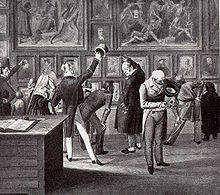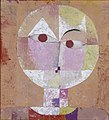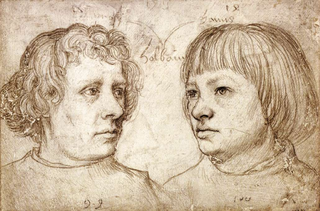
Ambrosius Holbein was a German and later a Swiss artist in painting, drawing, and printmaking. He was the elder brother, by about three years, of Hans Holbein the Younger, but he appears to have died in his mid-twenties, leaving behind only a small body of work.

Ferdinand Hodler was one of the best-known Swiss painters of the nineteenth century. His early works were portraits, landscapes, and genre paintings in a realistic style. Later, he adopted a personal form of symbolism which he called "parallelism".

The Kunstsammlung Nordrhein-Westfalen is the art collection of the German Federal State of North Rhine-Westphalia, in Düsseldorf. United by this institution are three different exhibition venues: the K20 at Grabbeplatz, the K21 in the Ständehaus, and the Schmela Haus. The Kunstsammlung was founded in 1961 by the state government of North Rhine-Westphalia as a foundation under private law for the purpose of displaying the art collection and expanding it through new acquisitions.

Isle of the Dead is the best-known painting of Swiss Symbolist artist Arnold Böcklin (1827–1901). Prints were very popular in central Europe in the early 20th century—Vladimir Nabokov observed in his 1936 novel Despair that they could be "found in every Berlin home".

The Kunsthaus Zürich is in terms of area the biggest art museum of Switzerland and houses one of the most important art collections in Switzerland, assembled over time by the local art association called Zürcher Kunstgesellschaft. The collection spans from the Middle Ages to contemporary art, with an emphasis on Swiss art.
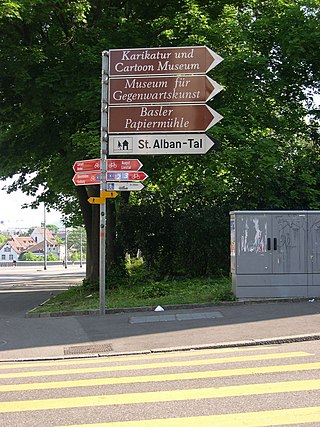
The Basel museums encompass a series of museums in the city of Basel, Switzerland, and the neighboring region. They represent a broad spectrum of collections with a marked concentration in the fine arts and house numerous holdings of international significance. With at least three dozen institutions, not including the local history collections in the surrounding communities, the region offers an extraordinarily high density of museums compared to other metropolitan areas of similar size. They draw some one and a half million visitors annually.
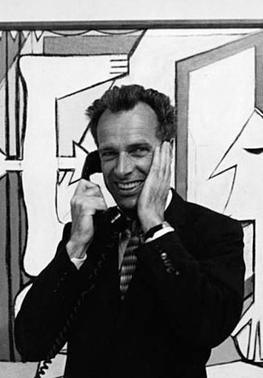
Ernst Beyeler was a Swiss art dealer and collector, who became "Europe’s pre-eminent dealer in modern art", according to The New York Times, and "the greatest art dealer since the war", according to The Daily Telegraph. In 1982, he and his wife founded the Beyeler Foundation to show his private collection, which on his death was valued at US$1.85 billion.

The Kunstmuseum Solothurn or Art Museum Solothurn is an art museum in the Swiss town Solothurn.
The Amerbach Cabinet was a collection of artifacts, paintings, libraries, assembled by members of the Amerbach family, most notably by the two law professors of the University of Basel, Bonifacius Amerbach and his son Basilius Amerbach the Younger.
Hans Danuser is a Swiss artist and photographer. His first major work, the cycle In Vivo, brought him international fame, therein he broke several societal taboos with respect to genetic research and nuclear physics. Since the 1990s, in addition to his photographic studies, Danuser has focused increasingly on transdisciplinary (research) projects in the arts and sciences.

Hans Holbein the Younger painted the Portrait of Erasmus of Rotterdam several times, and his paintings were much copied, at the time and later. It is difficult to disentangle Holbein's original work from that of his workshop and other copyists. Possibly five largely original versions survive, as well as a number of drawings made as studies.
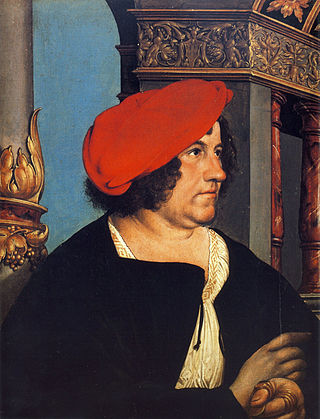
The Double Portrait of Jakob Meyer zum Hasen and Dorothea Kannengießer is a 1516 oil-on-limewood panel painting by Hans Holbein the Younger. The two panels were commissioned by Jakob Meyer zum Hasen, mayor of Basel, and show him and his second wife Dorothea Kannengießer. The occasion for the portrait could be Meyer zum Hasen's election as the mayor the same year. Holbein was eighteen years old at the time and had arrived in Basel together with his brother Ambrosius only in 1515. He signed with the letters HH. He received the right to sign with his full name in 1519, when he was accepted as a member of the painters' guild of Basel.

Josef Müller was a Swiss art collector and curator.
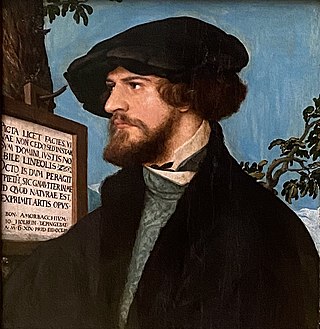
Bonifacius Amerbach was a jurist, scholar, an influential humanist and the rector of the University of Basel for several terms.

The Portrait of Bonifacius Amerbach is a painting by the German master of the Renaissance Hans Holbein the Younger. It is deposited in the Basler Kunstmuseum as part of the Amerbach Cabinet. It is painted in mixed technique on pine panel and measures 29.9 cm x 28.3 cm.

In the 1967 Basel Picasso paintings purchase referendum, the people of Basel, Switzerland, voted for the purchase of two paintings by Pablo Picasso, Les deux frères (1906) and Arlequin assis (1923). The referendum took place on 17 December 1967, and the "yes" campaign was supported by the youth of Basel and the local football club FC Basel, among others. Picasso was astonished by the fact that people would vote in favor to buy his art in a majority vote, and invited Franz Meyer, the director of the Kunstmuseum Basel, to see him at his atelier in Mougins, where he presented the "Youth of Basel" with four more of his works.

Remigius Faesch. was a Swiss jurist and rector of the University of Basel.

Portrait of the Artist's Family is a portrait of the family of the painter Hans Holbein the Younger by the artist himself. It depicts Holbein's wife Elsbeth Binzenstock, their son Philipp and their daughter Katharina. Holbein painted it during his stay in Basel after his return from England. It was painted, between 1528 and 1529, on paper and glued on wood.

In 1939 the Gallery Fischer in Lucerne organized an auction of degenerate art confiscated by the Nazis. The auction took place on 30 June 1939 in the Grand Hotel National. The auction received considerable international interest, but many of the bidders who were expected to attend were absent because they were worried the proceeds would be used by the Nazi regime.
Lotte von Mendelssohn-Bartholdy was a German author and art collector.


